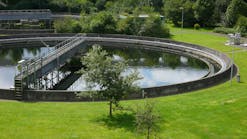Oklahoma, New Jersey and Idaho are the latest states to receive Bipartisan Infrastructure Law funding amounting to more than $300 million.
The U.S. EPA announced $105 million will go toward the Oklahoma Department of Environmental Protection for disbursement via Drinking Water State Revolving Funds (DWSRF) and Clean Water State Revolving Funds (CWSRF). New Jersey received $169 million for DWSRF and CWSRF projects, and the Idaho Department of Environmental Protection announced $60 million in funding will be used for 11 drinking water and wastewater projects in Idaho.
Oklahoma Water Infrastructure Funding Details
During a ceremony Dec. 1, Oklahoma Secretary of Energy and Environment Ken McQueen accepted a ceremonial check on behalf of all parties. In an EPA Region 6 press release, McQueen said the department is excited about the partnership to bring funding to the Sooner State for water infrastructure.
"Our highly experienced Oklahoma water professionals at Department of Environmental Quality and Water Resources Board aggressively pursued all of these grant opportunities, which resulted in over one-hundred million dollars of additional funding for communities across Oklahoma,” said Ken McQueen, Oklahoma Secretary of Energy and Environment. “These grants will provide much needed assistance in reducing nitrates and manganese from drinking water supplies, as well as providing targeted loan forgiveness in communities needing additional funding assistance.”
Clean Water Allotment
The Oklahoma CWSRF program will receive $15 million to construct municipal wastewater facilities and decentralized wastewater systems. Additional focuses for this funding to eligible recipients include control of nonpoint sources of pollution, green infrastructure, project estuaries and other water quality projects. The EPA press release also noted “nearly half of the grant will focus on assisting disadvantaged communities across the state.”
Drinking Water Allotment
According to the U.S. EPA press release announcing the funding for Oklahoma, $71 million will be allocated toward drinking water projects. The affected projects aim to improve water supply sources, replace and repair water storage tanks, fix aging water distribution systetsm and upgrade drinking water treatment systems across the state. The drinking water projects will be funded through the Oklahoma DWSRF program.
New Jersey Infrastructure Funding Announcement
Following approval of New Jersey’s state implementation plan, the U.S. EPA announced an award of $169 million in funding for the DWSRF and CWSRF in The Garden State. New Jersey Commissioner of Environmental Protection Shawn M. LaTourette linked the approved funding to New Jersey’s broader plans for water infrastructure improvements.
“Bipartisan Infrastructure Law funding from EPA is helping to power New Jersey's Water Infrastructure Investment Plan, enabling the Murphy Administration to reach even more communities with needed improvements to drinking water and wastewater systems," said New Jersey Commissioner of Environmental Protection Shawn M. LaTourette. “Together, we can ensure that generations of New Jerseyans receive reliably clean drinking water and enjoy fishable and swimmable waterways free of pollution – creating thousands of good-paying, family-sustaining jobs in the process."
The funds awarded are for fiscal year 2022 for New Jersey, according to the EPA Region 2 press release.
Clean Water Allotment
According to the EPA Region 2 press release, more than $73 million will account for clean water projects, which primarily will fund wastewater infrastructure projects in New Jersey. This funding supplements $48 million in “regular funding” for the NJ Clean Water SRF program in FY2022.
Drinking Water Allotment
More than $95 million will be awarded through the NJ Drinking Water SRF program. According to the EPA Region 2 press release, this funding includes $48 million to identify and replace lead service lines, $31 million to drinking water projects and $17 million to address emerging contaminants such as per- and polyfluoroalkyl substances.
Idaho Lists Planned Water & Wastewater Infrastructure Projects
The Idaho Department of Environmental protection announced the $60 million in infrastructure funding will be used for 11 projects across the state. In the Idaho DEP press release, Gov. Brad Little highlighted the importance of water as resource and noted the value of federal infrastructure funding in keeping property taxes in the state low.
“Water is our most valuable resource, and we absolutely must keep up the infrastructure to ensure water is clean and plentiful for this generation and future ones,” Gov. Little said. “That is why we made historic investments in water quality and quantity this year as part of my ‘Leading Idaho’ plan. These investments also could keep your property taxes low. Property taxes are determined locally but the investments we made in water and other infrastructure needs at the state level help relieve the burden on local government to cover costs of projects, improving the chances property owners won’t be burdened with the costs.”
Clean Water Projects Funded
- The city of Craigmont in Lewis County was awarded $5,198,059 for new headworks, biosolids, and ammonia removal, lagoon rehabilitation, and a new disinfection system, infiltration/inflow corrections, and collection work.
- The city of Moyie Springs in in Boundary County was awarded $2,100,000 to supplement material and labor cost overruns associated with their existing project, which consists of upgrading the treatment system and building a discharge line to the Kootenai River.
- The city of Rigby in Jefferson County was awarded $23,000,000 to retain the Nuvoda Mobile Organic Biofilm (MOB) system and add the following major components: septage receiving box, a redundant Nuvoda MOB screen, new oxidation ditches, secondary clarifiers, tertiary filters, pumping upgrades, a new ultraviolet system, new plant water pumps, new screen press, an additional emergency generator, electrical upgrades, and supervisory control and data acquisition improvements.
- The city of Juliaetta in Latah County was awarded $1,700,000 to supplement material and labor cost overruns to their existing project, which consists of rehabilitating replacing their lift station and adding new headworks, new aeration, secondary clarifiers, new dewatering equipment, new temperature and flow monitoring controls, backup generator, composite samplers, and temperature treatment.
- The city of Genesee in Latah County was awarded $3,762,000 to supplement material and labor cost overruns to their existing project, which consists of replacing the collection system, improving the wastewater treatment system, and adding a new headworks facility, lagoon system, and ultraviolet disinfection.
- The city of Kooskia in Idaho County was awarded $6,123,629 to add mechanical screening headworks, improve the lagoon diffused aeration, reconstruct the existing treatment lagoons, replace aging sewer mains, perform sewer system rehabilitation including replacement of lift station pumps, and install instruments and controls at the city’s lift stations.
Drinking Water Projects Funded
- Bennington Water System, Inc.: $2,400,000 to supplement material and labor cost overruns associated with their existing project, which consists of redeveloping Spring No. 2 and constructing a 150,000-gallon storage tank, disinfection facility, blending line, and transmission line.
- The city of Lewiston in Nez Perce County was awarded $7,300,000 to supplement material and labor cost overruns associated with their existing project, which consists of upgrading the water treatment system, replacing undersized mains, upgrading the booster pumping facility, and constructing a new well supply and water storage reservoir.
- Remington Recreational Water and Sewer District in Kootenai County was awarded $1,000,000 to supplement material and labor cost overruns associated with their existing project, which consists of improving the source, storage and booster capacity and adding new transmission and distribution lines.
- The city of New Meadows in Adams County was awarded $1,877,700 to construct a well facility for Well No. 5, replace the reservoir and booster station, update the city’s supervisory control and data acquisition system, and address cost overruns pertaining to their existing project.
- The city of Challis in Custer County was awarded $3,000,000 for the continued construction of a new well, well house, booster station, transmission line and to perform leak detection on water lines.
- The city of Genesee in Latah County was awarded $1,726,031 for the design and construction of Well No. 9, including a well house, yard piping, design and distribution components, and design improvements to the Fir Street boosted pressure zone.





